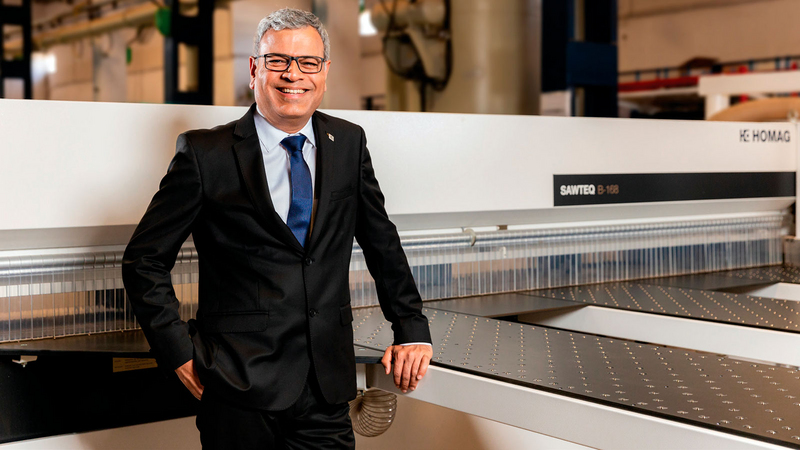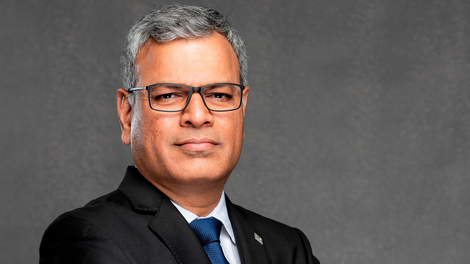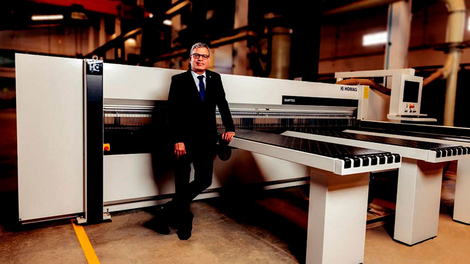HOMAG India goes the VOC way!
Steered by Mr Venkataramana Gorti, the newly-appointed Managing Director and Country Head of HOMAG India, the company sets its focus on the Voice of Customers (VOC) while continuing to be the ace technology partner for the Indian furniture manufacturing industry. Read on to find out the ‘what’, ‘why’ and ‘how’:
‘Technology’ is the buzzword that resonates with brand HOMAG. But the German manufacturer of woodworking machinery and leader in panel processing is going a step further. HOMAG will henceforth be synonymous with ‘Solutions’ as well.
What is more, with a new team headed by Mr Venkataramana Gorti, the new Managing Director and Country Head of HOMAG India, the company is moving towards the “voice of our customers”. Venkat says, “The Indian subsidiary will henceforth play a major role in HOMAG’s business strategy. It is a market that has been earmarked by the parent company for bigger growth, and we are raring to accomplish it.”
Venkat (as he is better known) is a graduate of the Indian Institute of Management, Bengaluru. He has headed factory operations and been in strategic sourcing roles in Wipro Infrastructure Engineering,General Electric, Honeywell, ABB and Flextronics in Malaysia and the US. He is also a Lean Six Sigma expert for the past two decades.
As a first step, the Indian subsidiary of the German technology provider recently underwent a consolidation of its assets – its manufacturing expertise, sales and service teams, its leadership and physical assets in Bengaluru.
In what was a “well thought out” restructuring plan, HOMAG’s manufacturing facility and the sales and service entity merged into one; its market strategy more aligned to meet Indian industry requirements; and the teams primed to meet goals set by the fresh focus.
HOMAG India has consolidated its presence on the National Highway in Nelamangala, where a bigger demonstration centre is in place and larger training facilities are coming up.
New Vision
The Country Head (India) for HOMAG thinks the entry of some major global players in the Indian market is a great fizz to have for a nascent modular furniture manufacturing industry. “Their entry seemed disruptive at first glance, but it will be a stupendous learning experience for Indian industry,” Venkat says.
They would be driving a big change and establishing global benchmarks in India – from making the industry aware of manufacturing processes, focus on customer satisfaction and the importance of design and finishing, to scaling up production, increasing efficiencies, using new materials and maintaining control over cost to stay relevant and competitive.
In such a scenario, HOMAG sees itself offering an off-the-shelf choice for machinery and solutions for the eco-system. HOMAG India has a straight advantage of horizontal implementation of its global standards to the Indian VOC.
“It would be our vision to see Indian manufacturers making it big on the global scene. For that we would stay immensely committed to put them on that stage with technology and innovations,” he stresses.
With a fresh approach to dealing with the industry, Venkat has his sights set:
- Add impetus for the growth of corporate furniture makers and suppliers;
- Empower the timber-processing industry to climb up the value chain;
- Enable suppliers to e-commerce platforms to upgrade their processes;
- Guide potential investors who are waiting for a good business opportunity;
- Be an enabler in bringing the furniture making industry to a mature stage.
HOMAG India has now further streamlined processes to play its role as knowledge facilitator, business guide and technology provider, says Venkat. “We can hand-hold new investors in setting up their projects; and assist existing manufacturers to upgrade and stay competitive,” he adds.
New Strategy
Venkat says HOMAG’s new strategy is three-pronged:
- Resonate and be coherent to the voice of its customers, their needs and ambitions;
- Work with them to ensure their growth projections are met and help them retain their competitive edge;
- Realign from product-centric selling to providing viable, relevant and sustainable solutions
“At IndiaWood 2020, visitors can get to see for themselves the first indications of HOMAG’s ‘Voice of Customers’ approach,” he says, adding that another shift in strategy is to graduate from incremental to quantum growth in business across the sub-continent.
“Towards this end, we are transforming the entire organisation. We are enhancing our business processes through HOMAG Group Production Systems 2.0, and putting in place more robust and scalable systems, which will contribute to the growth of the industry and keep pace with market expectations,” Venkat says.
An equally major role will be played by team dynamics. “Trust and transparency are my buzz words in my organisation, from the shop floor to the top floor,” asserts Venkat.
There is a larger stress on involving all HOMAG verticals in the business – from panel processing and finishing to material handling, automation and IoT-enabled (Internet of Things) systems. “Already, most of HOMAG’s machines are TAPIO-enabled and we are in the process of integrating aspects of augmented and virtual reality (AR/VR),” he adds.
There will also be a more clear segmentation of HOMAG’s products (at present it offers more than 250 types of machines for furniture manufacturing!); a greater play in geographies, including exports. “An expansion of the existing HOMAG product portfolio in India is also on the cards,” Venkat reveals.
RoI on Technology
According to Venkat the curiosity about factory automation and IoT-enabled technology is very big in India. HOMAG has been a pioneer in this as well. But there isn’t adequate awareness and education about the benefits accruing from them.
“With the proven TAPIO platform, there will be a change in the way our Indian customers are going to see their facilities enhanced. That will be where HOMAG will proactively start its next rise,” he says.
“Most software is about simplification – it takes the sweat out of the man behind the machine and enables him to focus on productivity. For businesses it means less stress on account of operator costs and manpower attrition,” Venkat notes.
The main sentiment among Indian manufacturers is on account of their simplistic view on return on investment. But the total cost of ownership on account of automation can be calculated from the following factors: optimal manpower, low learning curve, less material wastage, better precision, consistency and product quality, and higher production efficiency.
“So far as IoT is concerned, it is a wholly proactive and predictive technology. It is about cutting wastage, increasing efficiency, reducing chances of down time (due to machine maintenance and breakdowns), as well as the ability to monitor production runs – remotely and in real time,” Venkat emphasises.
HOMAG has now put together a team in India to develop software for its global footprint and to optimise its India operations. Since knowledge sharing and practical training are such big enablers for the growth of any industry, HOMAG will incorporate these into not only the Indian industry but for global markets as well.
Growth Potential
Because India is among the top importers of furniture, there is a yawning gap – Venkat insists it is a “big opportunity” – in manufacturing and supplying to a booming market. The rise in demand for housing is not exclusive to urban agglomerations – it comes also from towns and villages.
Global investors have, in the past few years, partnered with Indian giants in the real estate sector. The customer mix comprises of Millennials, Gen-X and Gen-Y. Smaller co-working spaces are also mushrooming in the country’s hinterland. These investments are spread across metros, Tier-2 cities and towns all over the country. And therein lies a vast untapped market, notes Venkat.
The multi-billion-dollar Indian furniture industry is still in a nascent stage and is not yet organised. It is here that HOMAG will be playing a more proactive role in its education, consolidation and growth.
Many furniture exporters are upgrading machinery and production processes to meet new global regulations, satisfy market demands and stay ahead of the competition. Several housing construction companies have resorted to backward integration by setting up p their own door/window manufacturing facilities – and many more are in the pipeline, Venkat says.
There are several big players in the home furnishing sector, including multi- national corporations, who are in the process of integrating home and retail furniture manufacturing. And there are as many established industrial houses that are venturing into furniture, Venkat says. They are all waiting for the right opportunity to mark their entry over the next few year.



